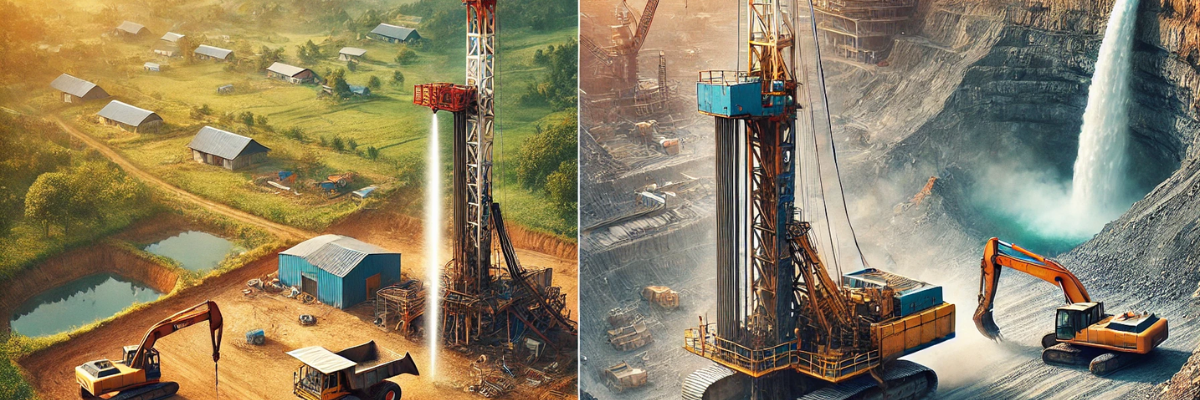Drilling operations require specialized rigs designed to suit specific purposes. While borewell drilling rigs and mining rigs both involve drilling into the earth, their applications, functionality, and design differ significantly. This article provides an in-depth comparison to help understand their unique characteristics and usage.
1. Purpose & Primary Application
Borewell Drilling Rigs:
- Designed to access underground water for residential, agricultural, and industrial use.
- Typically used in water well drilling, shallow environmental exploration, and sometimes small-scale oil drilling.
- Primarily suited for vertical drilling to reach aquifers efficiently.
Mining Rigs:
- Engineered for mineral and resource extraction, such as coal, metal ores, and precious minerals.
- Used in surface and underground mining operations to extract valuable materials from deep within the earth.
- Includes blast hole drilling, core sampling, and tunnel boring rigs, tailored for different mining applications.
2. Drilling Depth & Diameter
Borewell Drilling Rigs:
- Boreholes typically range from 4 to 12 inches in diameter.
- Capable of reaching depths of 100–500 meters, depending on the groundwater table.
Mining Rigs:
- Designed for both vertical and horizontal drilling, essential for resource extraction.
- Can reach depths of hundreds to thousands of meters, depending on the mining method and resource type.
- Hole diameters vary significantly, particularly in surface mining, where large blast holes are required.
3. Drilling Techniques Used
Borewell Drilling Rigs:
- Rotary Drilling: Uses a rotating drill bit to break through soil and rock layers.
- Down-the-Hole (DTH) Hammer Drilling: Uses high-impact percussive action combined with rotation to break hard formations efficiently.
- Auger Drilling: Suitable for soft soil formations, commonly used in environmental studies.
Mining Rigs:
- Rotary and Percussive Drilling: Used for blast hole creation in open-pit mining.
- Diamond Core Drilling: Retrieves cylindrical rock samples to assess mineral deposits.
- Reverse Circulation (RC) Drilling: Common in exploration for collecting rock chips.
- Long-Hole Drilling: Essential for underground mining to extract ore efficiently.
4. Power, Size, and Performance
Borewell Drilling Rigs:
- Smaller and mobile, usually truck- or tractor-mounted for easy transport.
- Powered by diesel or electric motors, with moderate drilling power suited for softer formations.
- Designed for single-location drilling with quick relocation capability.
Mining Rigs:
- Larger, heavier, and high-powered machines requiring specialized transport.
- Some are crawler-mounted, allowing movement within mining sites, but generally remain in one area for extended periods.
- Built to withstand extreme conditions, such as high pressures and hard rock formations.
5. Durability & Strength
Borewell Drilling Rigs:
- Built for medium-duty operations, mainly drilling through soil, sand, and moderate rock formations.
- Lifespan depends on terrain conditions and operational load.
Mining Rigs:
- Heavy-duty machines designed to drill through the toughest rock formations like granite and basalt.
- Engineered to withstand harsh mining conditions, extreme temperatures, and high-pressure operations
6. Key Applications & Industry Use
Borewell Drilling Rigs:
- Water well drilling for residential, agricultural, and industrial water supply.
- Environmental and geotechnical drilling for soil testing and groundwater assessment.
- Shallow exploratory drilling for small-scale oil and gas extraction.
Mining Rigs:
- Coal, metal, and mineral extraction in underground and surface mines.
- Exploration drilling for resource mapping and deposit analysis.
- Blast hole drilling for large-scale resource extraction and tunnel construction.
7. Cost & Investment Considerations
Borewell Drilling Rigs:
- Lower cost due to smaller size and moderate power requirements.
- Lower operational costs and maintenance compared to mining rigs.
Mining Rigs:
- Higher initial investment due to size, complexity, and durability.
- High maintenance costs, as they require specialized technicians and spare parts.
- Often includes advanced automation features like GPS, AI-assisted drilling, and remote monitoring.
8. Mobility & Deployment
Borewell Drilling Rigs:
- Highly mobile, usually mounted on trucks, making them easy to transport between sites.
- Suitable for projects requiring frequent relocations, such as drilling multiple boreholes across a region.
Mining Rigs:
- Less mobile, especially underground drilling rigs, which are often stationed at one location for long periods.
- Requires specialized transport equipment for relocation.
9. Environmental Impact
Borewell Drilling Rigs:
- Minimal environmental impact, as boreholes are relatively small.
- Possible groundwater depletion or contamination risks if drilling is not managed properly.
Mining Rigs:
- Higher environmental impact due to large-scale excavation and material extraction.
- potential for habitat destruction, erosion, and pollution—especially in surface mining operations.
10. Operational Complexity & Training Requirements
Borewell Drilling Rigs:
- Easier to operate, requiring less technical expertise.
- Suitable for smaller teams with moderate training.
Mining Rigs:
- Highly complex, requiring skilled operators and engineers.
- Often incorporates advanced drilling software and automation for precision and efficiency.

